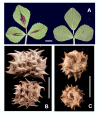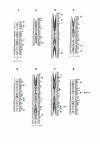The molecular genetic linkage map of the model legume Medicago truncatula: an essential tool for comparative legume genomics and the isolation of agronomically important genes
- PMID: 11825338
- PMCID: PMC65051
- DOI: 10.1186/1471-2229-2-1
The molecular genetic linkage map of the model legume Medicago truncatula: an essential tool for comparative legume genomics and the isolation of agronomically important genes
Abstract
Background: The legume Medicago truncatula has emerged as a model plant for the molecular and genetic dissection of various plant processes involved in rhizobial, mycorrhizal and pathogenic plant-microbe interactions. Aiming to develop essential tools for such genetic approaches, we have established the first genetic map of this species. Two parental homozygous lines were selected from the cultivar Jemalong and from the Algerian natural population (DZA315) on the basis of their molecular and phenotypic polymorphism.
Results: An F2 segregating population of 124 individuals between these two lines was obtained using an efficient manual crossing technique established for M. truncatula and was used to construct a genetic map. This map spans 1225 cM (average 470 kb/cM) and comprises 289 markers including RAPD, AFLP, known genes and isoenzymes arranged in 8 linkage groups (2n = 16). Markers are uniformly distributed throughout the map and segregation distortion is limited to only 3 linkage groups. By mapping a number of common markers, the eight linkage groups are shown to be homologous to those of diploid alfalfa (M. sativa), implying a good level of macrosynteny between the two genomes. Using this M. truncatula map and the derived F3 populations, we were able to map the Mtsym6 symbiotic gene on linkage group 8 and the SPC gene, responsible for the direction of pod coiling, on linkage group 7.
Conclusions: These results demonstrate that Medicago truncatula is amenable to diploid genetic analysis and they open the way to map-based cloning of symbiotic or other agronomically-important genes using this model plant.
Figures




References
-
- Cook D, Dénarié J. Progress in the genomics of Medicago truncatula and the promise of its application to grain legume crops. Grain Legumes. 2000;28:12–13.
-
- Barker DG, Bianchi S, Blondon F, Dattée Y, Duc G, Flament P, Gallusci P, Génier G, Guy P, Muel X, Tourneur J, Dénarié J, Huguet T. Medicago truncatula, a model plant for studying the molecular genetics of the Rhizobium-iegume symbiosis. Plant Mol Biol Rep. 1990;8:40–49.
-
- Cook D, Vandenbosch K, DeBruijn F, Huguet T. Model legumes get the Nod. Plant Cell. 1997;9:275–281. doi: 10.1105/tpc.9.3.275. - DOI
Publication types
MeSH terms
Substances
LinkOut - more resources
Full Text Sources
Other Literature Sources
Miscellaneous

